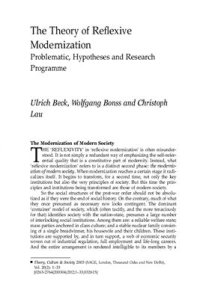
Ebook: The theory of reflexive modernization
- Genre: Other Social Sciences // Sociology
- Tags: Социологические дисциплины, Первоисточники по социологии, Бек Ульрих
- Language: English
- pdf
Article in: Theory, Culture & Society 2003 (SAGE, London, Thousand Oaks and New Delhi),
Vol. 20(2): 1–33Abstract:
How can one distinguish the concept of second modernity from the concept of postmodernity? Postmodernists are interested in deconstruction without reconstruction, second modernity is about deconstruction and reconstruction. Social sciences need to construct new concepts to understand the world dynamics at the beginning of the 21st century. Modernity has not vanished, we are not post it. Radical social change has always been part of modernity. What is new is that modernity has begun to modernize its own foundations. This is what it means to say modernity has become reflexive. It has become directed at itself. This causes huge new problems both in reality and in theory. There has been a pluralization of the boundaries within and between societies, between society and nature, between Us and Other, between life and death. This pluralization also changes the inherent nature of boundaries. They become not so much boundaries as a variety of attempts to draw of boundaries. Border conflicts become transformed into conflicts over the drawing of boundaries. Where postmodernism simply celebrates this multiplication of boundaries, the theory of second modernity starts with the problem this new reality poses for individual and collective decisions, and with the problem that the continued existence of such decisions poses for theory. Institutions that are capable of such conscious boundary drawing are enabled in a way that those of the first modernity were not. But this process also generates qualitatively new kinds of trouble and crises. To investigate those troubles is to unveil the emergence of the second modernity.
Vol. 20(2): 1–33Abstract:
How can one distinguish the concept of second modernity from the concept of postmodernity? Postmodernists are interested in deconstruction without reconstruction, second modernity is about deconstruction and reconstruction. Social sciences need to construct new concepts to understand the world dynamics at the beginning of the 21st century. Modernity has not vanished, we are not post it. Radical social change has always been part of modernity. What is new is that modernity has begun to modernize its own foundations. This is what it means to say modernity has become reflexive. It has become directed at itself. This causes huge new problems both in reality and in theory. There has been a pluralization of the boundaries within and between societies, between society and nature, between Us and Other, between life and death. This pluralization also changes the inherent nature of boundaries. They become not so much boundaries as a variety of attempts to draw of boundaries. Border conflicts become transformed into conflicts over the drawing of boundaries. Where postmodernism simply celebrates this multiplication of boundaries, the theory of second modernity starts with the problem this new reality poses for individual and collective decisions, and with the problem that the continued existence of such decisions poses for theory. Institutions that are capable of such conscious boundary drawing are enabled in a way that those of the first modernity were not. But this process also generates qualitatively new kinds of trouble and crises. To investigate those troubles is to unveil the emergence of the second modernity.
Download the book The theory of reflexive modernization for free or read online
Continue reading on any device:

Last viewed books
Related books
{related-news}
Comments (0)